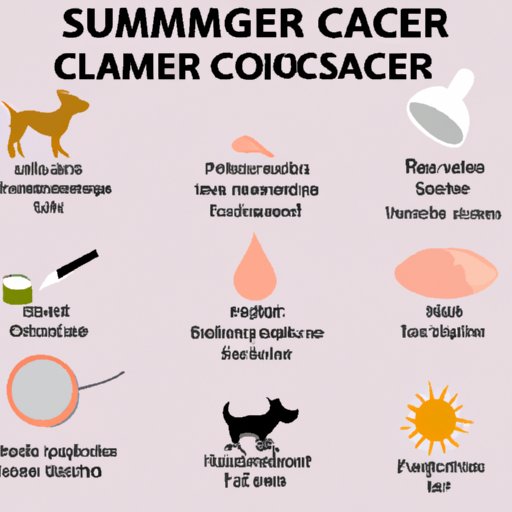Introduction
Skin cancer is the most common type of cancer in dogs and cats. It affects all breeds and ages, but some types are more likely to occur in certain breeds or age groups. Just like humans, dogs can develop melanoma, squamous cell carcinoma, and basal cell carcinoma. It’s important to be aware of the signs and symptoms of skin cancer so you can recognize them early and get your pet treated as soon as possible.
This article will provide an overview of skin cancer in dogs and discuss what it looks like on a dog. We’ll also cover how to perform a skin cancer checkup on your dog, the common symptoms of skin cancer in canines, and the various treatments available. Finally, we’ll discuss the importance of early detection and warning signs of skin cancer in dogs.
A Pictorial Guide to Spotting Skin Cancer in Dogs
Skin cancer in dogs can manifest itself in many different forms, so it’s important to be able to recognize the signs. Here are some pictures of skin cancer on dogs that may help you identify the condition:

This picture shows a large tumor on a dog’s chest. This type of mass is often indicative of skin cancer.

This photo shows multiple moles on a dog’s back. While not all moles are indicative of skin cancer, any changes in size, shape, color, or texture should be checked by a veterinarian.

This image shows multiple lesions on a dog’s face. These could be indicative of skin cancer.
What to Look For
When inspecting your dog for signs of skin cancer, there are certain things you should look for. The following are some common indicators of abnormal growths that may be skin cancer:
- Lumps, bumps, or masses
- Moles or freckles that change in size, shape, color, or texture
- Lesions or sores that don’t heal
- Itching or discomfort
- Inflammation

Common Symptoms of Skin Cancer in Canines
In addition to the physical signs of skin cancer, there are several common symptoms that can indicate the presence of the disease. These include:
Changes in Appearance
One of the most obvious symptoms of skin cancer in dogs is a change in appearance. This can include lumps, bumps, or masses that appear suddenly and continue to grow. It can also include moles or freckles that change in size, shape, color, or texture.
Inflammation
Inflammation is another common symptom of skin cancer in dogs. If you notice that your dog’s skin is red, swollen, or irritated, it could be a sign of skin cancer.
Sores and Lesions
Sores and lesions are another symptom of skin cancer in dogs. These can range from small bumps to large ulcerated areas. They may be painful or itchy and may bleed or ooze fluid.
Itching or Discomfort
If your dog is scratching or licking at a particular area of their body, it could be a sign of skin cancer. This itching or discomfort may be caused by the presence of a tumor or other abnormality.

How to Perform a Skin Cancer Checkup on Your Dog
Performing a skin cancer checkup on your dog is a simple process. First, inspect your dog’s skin for any abnormalities such as lumps, bumps, or moles. Pay special attention to areas with hair loss or discoloration. Next, monitor your dog for any changes in their skin, such as new lumps or moles, or changes in existing ones. Finally, if you notice anything suspicious, seek professional help from your veterinarian.

What Pet Owners Need to Know About Dog Skin Cancer
There are several types of skin cancer in dogs, including melanoma, squamous cell carcinoma, and basal cell carcinoma. All three types can be found anywhere on the body, but they are most commonly found on the head, neck, and legs. Risk factors for skin cancer in dogs include age, breed, and sun exposure. Prevention methods include avoiding excessive sun exposure, using sunscreen, and regularly checking your dog’s skin for any changes or abnormalities.
Diagnosing and Treating Skin Cancer in Dogs
Diagnosing skin cancer in dogs usually involves a biopsy of the affected area. This is done by taking a sample of the tissue and sending it to a laboratory for examination. Once the diagnosis is confirmed, treatment options may include surgery, chemotherapy, radiation therapy, immunotherapy, or a combination of these treatments.
Recognizing the Signs of Skin Cancer in Your Dog
Early detection is key when it comes to treating skin cancer in dogs. It’s important to be aware of the signs and symptoms of the disease so you can recognize them early and get your pet treated as soon as possible. Some warning signs to look out for include lumps, bumps, or masses; moles or freckles that change in size, shape, color, or texture; lesions or sores that don’t heal; itching or discomfort; and inflammation.
Conclusion
Skin cancer is the most common type of cancer in dogs and cats. It’s important to be aware of the signs and symptoms of skin cancer so you can recognize them early and get your pet treated as soon as possible. This article has provided an overview of skin cancer in dogs and discussed what it looks like on a dog. We’ve also covered how to perform a skin cancer checkup on your dog, the common symptoms of skin cancer in canines, and the various treatments available. Finally, we’ve discussed the importance of early detection and warning signs of skin cancer in dogs.
If you suspect your dog may have skin cancer, it’s important to seek professional help from your veterinarian as soon as possible. With early detection and proper treatment, skin cancer in dogs can be successfully managed.

Resources for Further Learning
American Veterinary Medical Association: https://www.avma.org/
PetMD: https://www.petmd.com/
VCA Hospitals: http://vcahospitals.com/


